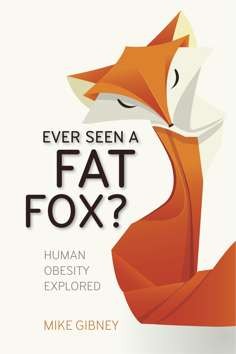
Seven myths that dominate the obesity debate debunked
From inheriting the propensity for weight gain to the real commercial villains behind obesity, Ever Seen a Fat Fox? author Michael Gibney dispels some common misunderstandings

Ever seen a fat fox? I didn’t think you had. Why is it that only humans – or animals in the care of humans – develop obesity? In my recently published book, Ever Seen a Fat Fox – Human Obesity Explored, I challenge some common myths that dominate the popular debate on the topic of obesity. Here are seven key issues that are often misunderstood or misrepresented.
Myth 1: the global effects of obesity are overinflated.
Truth: the global economic impact of obesity amounts to roughly US$2 trillion annually, or 2.8 per cent of global GDP.
The McKinsey Global Institute issues detailed reports of their in-depth analysis of many socially important issues. On the subject of obesity, they compared the costs to the UK National Health Service thus: the annual cost of obesity to the nation from obesity equals the combined annual cost of the UK police, fire, prison and court services. My estimate of the lifetime costs of obesity to the US makes it equivalent to both the construction costs and 40-year lifetime maintenance costs of about 30 to 40 US nuclear submarines of the Virginia class. That’s a lot of money. No matter how you look at it, obesity costs a small fortune.

Myth 2: widespread obesity is unique to modern times.
Truth: it began with the Industrial Revolution.
Whenever and wherever humans have experienced affluence we have witnessed widespread obesity. Writers throughout history have documented this, and just one needs to be quoted. In 1816, Sir William Wadd wrote in his book, Cursory Remarks on Corpulence: “If the increase of wealth and the refinement of modern times have tended to banish plague and pestilence from our cities, they have probably introduced the increased frequency of corpulence. For every one fat person in Spain or France, there are 100 in England.”
Indeed, obesity that we know today began in the Industrial Revolution and is best documented in military archives, particularly in the United States. At the very end of the 20th century, the medical director of the US Metropolitan Life Insurance Company published data showing how obesity at that time brought higher risks of heart disease, liver disease, diabetes and some cancers. What we have seen is a global problem in a world that changed in the 19th and 20th centuries with the Industrial Revolution, the growth of urban living, the rise of incomes, the wider availability of imported foods and, most of all, a dramatic fall in the price of food.
Myth 3: big corporates are the villains of the food industry.
Truth: small local companies account for the vast majority of global packaged food sales.
It is popular among the public, its political structures and media to have a guilty party to flog at every opportunity. In this instance it is Coca Cola, Nestlé, Mars, Mondelez, Danone and the like along with the technocrats who are wrongly blamed for concocting many of our favourite foods, which in the popular press are portrayed as manufactured specifically to be addictive and non-satiating.
Although the corporate names are popular whipping boys for our obesity, the reality is that the vast majority of food enterprises are small local companies. Asian data show the following: 97 per cent of food service companies have operating receipts well below US$100,000. The comparable figure for the top 2.5 per cent of such companies is almost US$1.5 million. The same is true the world over. Globally, the top 10 branded food companies account for just 15 per cent of global packaged food sales. In the EU, 99.1 per cent of all food companies are small to medium enterprises and large food companies comprise only 0.9 per cent.
So when it comes to product renovation and reformulation, most companies lack the cash or technology base to make multiple changes to improve the nutritional quality of their products. It is easy for the big names and they are doing it, but until local and artisanal players become involved, the problem of restructuring the food supply will remain.

Myth 4: some nutrients are more fattening than others.
Truth: it’s all about the calories.
Just as there are villains in the food sector, the food gurus would have us believe that certain nutrients are more fattening than others. At present, carbs are seen as the next tobacco while fat, once the villain, is now on parole pending complete vindication. This is utter balderdash. When it comes to obesity, it is worth paraphrasing Bill Clinton: “It’s the calories, stupid!”
Exhaustive international collaborative studies funded by entities as independent as the US National Institutes of Health and the BBC and conducted by some of the top universities in the world have confirmed the obvious: if you want to lose weight, restrict your calories to well below your needs and ideally increase your caloric needs with some daily exercise. It doesn’t matter if you lose disproportionate calories from carbs, sugar, protein, starch, fats or alcohol. As long as you eat much less than normal.
As Dolly Parton once said to the talk show host Michael Parkinson: “Honey, if you want to lose weight, get your head out of the slop bucket.”

Myth 5: processed food is a recent invention.
Truth: processed food is as old as civilisation.
Pizzas were street food in Naples and Venice almost 1,000 years ago; cakes and biscuits are as old as the oldest religions; sausages are ancient in Europe and unique to each region; popcorn garlands were worn by Aztec women as ceremonial dress; hamburgers and frankfurters were exported to the US two centuries ago and foods such as wine, bread, yogurt, sugar, honey, butter, cream and cheese are as old as civilisation.
Myth 6: genes don’t matter; it’s solely our food-rich environment.
Truth: genes have a part to play.
Nobody could argue that inexpensive and abundant supplies of food aren’t involved in the development of obesity. They are and that is beyond dispute. But within that environment we all share, our genes decide where exactly we end up on the obesity league table.
Endless twin studies using identical and non-identical twins show that about 75 per cent of weight-gain capacity is inherited, the remainder being due to our family environment in the case of children and young adults, as well as the unshared environment (sport versus music versus rock bands). As one guru in the field put it: genes load the gun, the environment pulls the trigger.
Why in the same home, the same street, the same school are some people able to maintain a normal weight while others stumble easily into overweight and eventually obesity? That is the great challenge to modern biology and while we may learn a lot from twin studies about the inheritance of obesity, the discovery of the actual genes involved will be a huge task to the future.

Myth 7: we can legislate ourselves out of the problem – just like smoking.
Truth: investment in community action programmes are needed.
To some extent, legislation such as labelling, packaging data, portion control, marketing and sales limitations, taxes and the like can all play a role. But at the end of the day, states will have to invest in local community initiatives to (a) prevent weight gain, (b) manage weight loss, (c) maintain weight loss and (d) help those for whom weight loss is beyond simple diets with surgical and pharmaceutical help. States will have to invest in community action programmes with a significant bottom-up approach.
Michael Gibney is Emeritus Professor of Food and Health at University College Dublin. He is a former president of the Nutrition Society and is a Fellow of the International Union of Nutritional Sciences. He also chairs the Food Safety Authority of Ireland